New Yorkers Run for President: History and Insights for 2016
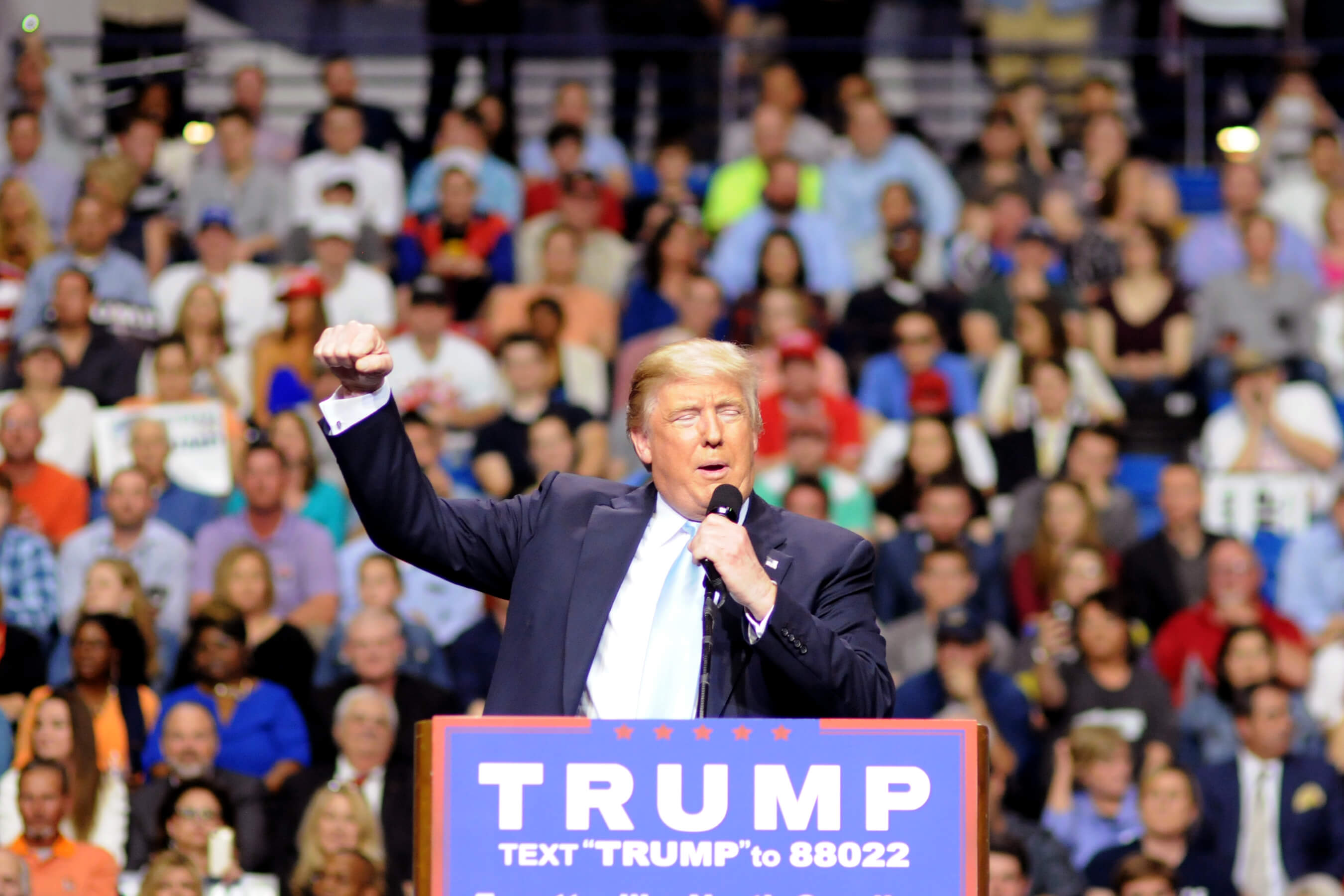
Donald Trump at a rally (photo: Trump campaign website)
continued from page 2 - this is page 3 of 3
Even more New Yorkers
If you count vice presidential nominees too, New Yorkers were on major ballots in 15 out of the 29 races from 1900 to 2012.
The New Yorker vice presidential nominees during the period since 1900 were Theodore Roosevelt, R, 1900; James Sherman, R, 1908; Franklin D. Roosevelt, D, 1920; William Miller, R, 1964; Geraldine Ferraro, D, 1984; and Jack Kemp, R, 1996. TR was elected with William McKinley. Sherman was elected with Taft (but died in office in 1912). The others went down to defeat along with the presidential nominees at the head of their tickets.
Of course, the list of New Yorkers in presidential politics gets even longer if you count prominent New Yorkers who were major contenders but failed to get the nomination. That would include Governors Nelson Rockefeller (R), who lost the nomination to Barry Goldwater in 1964 and Mario Cuomo (D) who agonized over whether to run in 1988 and 1992 and decided not to take the plunge.
The list would include Senator Robert Kennedy (D), who was assassinated during his quest for the 1968 Democratic presidential nomination. Rep. Shirley Chisolm, the first black woman elected to Congress (in 1968) campaigned for the Democratic presidential nomination in 1972. New York City Mayor John Lindsay switched from the Republican to the Democratic Party in 1971 and launched a brief but unsuccessful bid for the 1972 Democratic presidential nomination. Rudolph Giuliani (R), mayor from 1994 to 2001, sought his party's 2008 nomination, losing to John McCain.
Possible insights for 2016
It is always exciting when New Yorkers run for president! But finding parallels or applicable lessons from that history is a challenge. A few tentative insights:
*The New Yorkers who made it to the presidency in the 20th century -- Theodore Roosevelt and Franklin Roosevelt-- were among the nation's strongest presidents, constantly rated by historians in the top tier of our national leaders.
*Defeating a sitting President is difficult, as challengers learned in 1904, 1912, 1936, 1940, 1944, and 1948. On the other hand, running on the legacy of a previous president can help, as it did for Taft in 1908, Hoover in 1928, and Truman in 1948. That pattern may help Hillary Clinton, who can claim to be heir to at least some of Barack Obama's policies.
*Americans seem to prefer an exuberant campaign style over what might be called a judicious, restrained style. That subdued demeanor is sometimes associated with judges who are inclined to weigh and balance and look for nuances, e.g., possibly Parker in 1904, Hughes in 1916, and Taft (a judge before becoming TR's Secretary of War.)
*Red herrings and false issues can derail even a strong, thoughtful candidate, as Al Smith learned in 1928 when he was attacked for his religious beliefs.
*Wendell Willkie, a businessman who had never held political office, made a credible candidate in 1940. But his tenor and message were much different from businessman Donald Trump's today. He was a moderate, compromiser, inclined toward inclusion and accommodation, a unifier who tried to swing his party toward the mainstream.
*There may be a rough parallel between the "Stop Roosevelt!" campaign in the Republican party in 1911 and 1912 and the "Stop Trump!" campaign that some Republican leaders are mounting today. TR had triumphed in most of the primaries in 1912, though only a minority of states had them at that time, and could claim with some justification that where people had the chance to vote, they favored him as the Republican candidate. Trump is racking up primary wins this year. But TR expressed concrete, progressive, well-considered proposals and never resorted to bombast or bullying, which seem to be part of Trump's style.
*Hailing from New York can be a mixed blessing, as evidenced by Senator Ted Cruz' snide comment about Donald Trump representing "New York values." That sort of comment, with the vague innuendo it conveys, is something that Al Smith might have understood.
***
The New York presidential primaries are Tuesday, April 19; the general election will take place on Tuesday, November 8, 2016.
This is page 3 of 3. Revisit page 1 or page 2 of this article.
***
Dr. Bruce W. Dearstyne's latest book is The Spirit of New York: Defining Events in the Empire State's History, published in 2015 by SUNY Press.
***
Have an op-ed idea or submission for Gotham Gazette? Email This email address is being protected from spambots. You need JavaScript enabled to view it.
New Yorkers Run for President: History and Insights for 2016
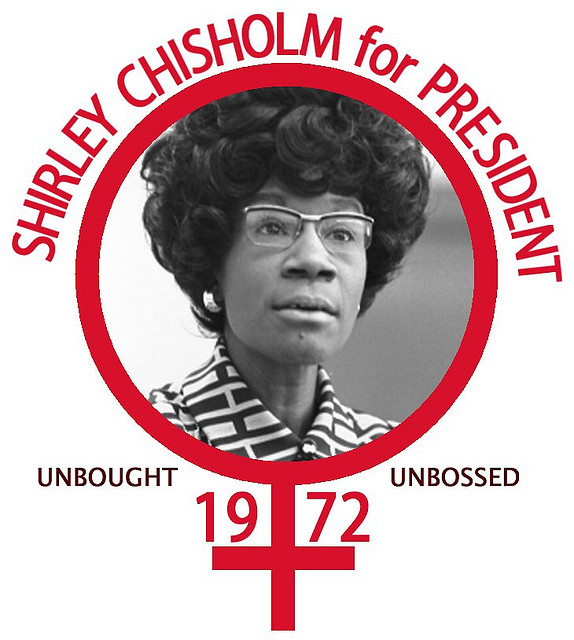
Shirley Chisolm for President, 1972
continued from page 1 - this is page 2 of 3
1932: New York's great depression fighter
Al Smith even lost his home state of New York in 1928, but his friend and colleague, Democrat Franklin D. Roosevelt, a former state senator, assistant secretary of the Navy, vice presidential candidate (in 1920), and distant cousin of Theodore Roosevelt, was elected governor. FDR proved an exceptionally capable governor, creating the nation's first state office to combat the Depression which settled onto the country after the stock market plunged in October 1929.
Hoover took limited steps at the federal level, including a program to make loans to sagging companies, but his measures were totally inadequate. Joblessness and despair rose. Hoover seemed indifferent. "Nobody is actually starving," the president told journalists. "The hobos, for example, are better fed than they have ever been." Homeless people lived in cardboard and tarpaper shacks dubbed "Hoovervilles." Hoover was re-nominated by his party but had no chance of winning.
Al Smith sought the Democratic nomination, arguing that Hoover's disastrous policies vindicated his progressive vision back in 1928. But Democrats turned to Roosevelt, an optimistic and capable leader who inspired confidence. FDR flew to Chicago to accept the nomination in person, something no other candidate had ever done. "I pledge to you...a New Deal for the American people" he told the convention.
The slogan "New Deal" stuck. FDR called for novel government methods to meet the unprecedented crisis but he was un-specific and some of his pledges, e.g., reducing federal spending, seemed outright conservative (and proved impossible to carry out). But his call for government action struck a chord among Americans weary of the Depression and Washington's seeming indifference. "The country needs and, unless I mistake its temper, the country demands bold, persistent experimentation," FDR said. "It is common sense to take a method and try it. If it fails, admit it frankly and try another. But above all, try something." Voters liked that can-do spirit. FDR carried all but six states.
1936: The New Deal endorsed
Roosevelt pushed through a dramatic array of "New Deal" reform measures in his first four years as president, including the National Recovery Act to help revive business; the Agricultural Adjustment Act to stimulate agricultural production; the Public Works Act to provide federal support for public highway and other public works projects; the Civilian Conservation Corps to provide jobs in reforesting; and other initiatives. As the economy slowly began to revive, he enacted still more reforms, including the Social Security Act in 1935. He proved to be a masterful leader who built confidence and support, even among potential opponents. When he needed a break from Washington, he travelled to his country home in Hyde Park, New York, which became almost an adjunct White House.
Easily re-nominated in 1936, FDR, a master campaigner, promised to extend and consolidate the New Deal. He denounced the Republicans as front men for "economic royalists," entrenched banking and business interests that had brought on the Depression and, given the chance, would root out the gains the New Deal had made for the American people. His administration had been struggling with "business and financial monopoly, speculation, reckless banking, class antagonism, sectionalism [and] war profiteering," he told an enthusiastic crowd at New York's Madison Square Garden near the end of the campaign. "Never before in all our history have these forces been so united against one candidate as they stand today. They are unanimous in their hate for me -- and I welcome that hatred."
Republicans had been challenged to find anyone willing to take Roosevelt on. They nominated Kansas Governor Alfred Landon, a lackluster, somewhat reluctant candidate. Landon actually agreed with much of the New Deal but dutifully attacked it for threatening American institutions, concentrating too much power in Washington, profligate spending, and excessive regulation. Sensing a need for a dramatic issue to energize his campaign, he called the Social Security law "unjust, unworkable, stupidly drafted, and wastefully financed," and a "glaring example of [New Deal] bungling and waste." He added that "It assumes that Americans are irresponsible [and] that old-age pensions are necessary because Americans lack the foresight to provide for their old age." Landon's appeal fell flat. FDR carried every state except Maine and Vermont.
1940: Sticking with proven leadership
By 1940, the depression was lifting and public attention turned toward the situation in Europe where war was raging and America's traditional allies, the British and French, were struggling against the onslaught of Nazi Germany. Aggression by Japanese imperial forces in the Far East was another rising concern. President Roosevelt searched for ways to assist the British in particular, but without violating U.S. laws which pledged the nation to neutrality. The Democrats, breaking with a tradition stretching back to George Washington of two-term limits for a president, nominated FDR for a third term. Roosevelt, like Wilson in 1916, stressed both preparedness and a commitment to peace. In one campaign speech, he assured parents that "your boys are not going to be sent into any foreign wars."
Republicans were discouraged -- people liked FDR's domestic policies, which seemed at last to be vanquishing the remnants of the Depression, and saw him as a strong leader needed at a time of international crisis. Party leaders, turning away from experienced politicians who could be tarred as obstructionists for their steadfast opposition to FDR's popular policies, sought a new, fresh candidate without Washington connections. They found him in Wendell Willkie, a public-utilities executive who had come to prominence as a leader in the fight against the Tennessee Valley Authority, a New Deal initiative for flood control and electricity generation in that region.
Willkie had switched from the Democratic to the Republican Party in 1939. He proved to be a magnetic, eloquent campaigner, critical of some New Deal measures but promising to keep most of it in tact if he were elected. He was mostly supportive of FDR's measured approach to international issues, breaking with Republican isolationists and conceding that the U.S. might have to intervene to stop aggression. But Democrats hammered at his lack of government experience, countering the Republican criticism of FDR seeking a third term with the chant "Better a Third Termer Than a Third Rater!" On Election Day, Willkie cut into FDR's 1932 and 1936 landslide majorities but lost by a sizeable margin. The next year, the Japanese attack on Pearl Harbor brought the U.S. into World War II. Willkie supported the president's wartime strategies and occasionally served as an informal international envoy for the administration.
1944: New York's capable new governor vs. the champ
Republican Thomas E. Dewey, who had made his reputation as a district attorney prosecuting organized crime figures in the 1930s and early '40s, was elected Governor of New York in 1942. Two years later, he sought the presidency. Dewey campaigned on his executive record -- New York had a budget surplus and the governor was developing plans for postwar business and veterans' benefits.
President Roosevelt seemed tired. He had lost weight and looked haggard. There were rumors that his health was failing. The war effort had gone well -- the allies invaded France on June 6, 1944, just as Dewey's campaign was ramping up -- but the war had spawned over 150 bureaus, many duplicative, adding to the image of too much government in Washington. The Republican platform advocated streamlined, cheaper, and more efficient government after the war. Four more years of FDR's policies, the platform warned, "would centralize all power in the President, and would daily subject every citizen to regulation by his henchman; and this country would remain a Republic only in name."
Dewey, the capable, conservative executive, seemed tailor-made for the job. After twelve years in power, the New Deal had grown "old and tired and quarrelsome," the administration racked by "wrangling, bungling, and confusion." Dewey was vague on his plans for a post-war world but promised to shrink the federal government. Otherwise, "we may slip by gradual stages into complete government regulation of every aspect of our lives," he warned.
Dewey was careful and systematic but also stiff, unexciting, and not very personable. FDR rekindled the likeability and trust that Americans had valued for so long. In a September speech, he went after a Republican accusation that the Navy had been ordered to rescue the president's dog, Fala, from the Aleutian Islands after a presidential trip there. "These Republican leaders have not been content with attacks on me, or my wife, or on my sons," the president said at a campaign rally. "No, not content with that, they now include my little dog, Fala. Well, of course, I don't resent attacks, and my family doesn't resent attacks, but Fala does resent them."
Democrats piled on: Dewey lacked international experience and knew how to attack and tear down but had little constructive vision for the future. Dewey's final speech -- "let us resolve to put aside these years of cynicism and conflict...to throw off the nightmare of past years and breathe once more the atmosphere of peace and good will" -- did little to inspire confidence. FDR was the only president many Americans had ever known. He had led the nation through the Depression and now seemed close to leading it to victory in war. FDR won overwhelmingly, with 391 to 140 electoral votes.
1948: New York's accomplished but overconfident governor
Apprehension about FDR's health in 1944 were providential. In April 1945, the president died and was succeeded by Vice President Harry Truman, who had been a Senator from Missouri. Truman was ill prepared for the presidency. FDR had not told him about the secret project to develop an atomic bomb, which Truman, once he understood its awesome destructive power, decided to use against the Japanese to end the war in August 1945.
The Truman administration was beset by allegations of mismanagement. It was struggling to deal with the onset of the Cold War and the menace of communism, particularly in eastern Europe. Truman was nominated for a full term as president but his Democratic party was less than optimistic. Liberals thought him too conservative and established their own Progressive Party (the same name but no relation to TR's 1912 group) and nominated Henry A. Wallace, FDR's vice president from 1940 to 1944, to run for president. Many southern Democrats disliked Truman's civil rights positions and formed the States' Rights Democratic Party, dubbed the "Dixiecrats," and nominated South Carolina Governor Strom Thurmond for president. Truman's prospects looked dim.
Dewey, re-elected governor in 1946, by contrast, looked stronger than ever. He had maintained New York's budget surplus, signed the nation's first state civil rights bill, initiated the New York State Thruway, established the State Commerce Department to stimulate the post-war economy, and launched the State University of New York. The Republicans decided he deserved another shot at the presidency. As a campaigner, though, he proved to be overconfident (he called his campaign train the Victory Special) and vague, admitting he had "no easy answers" and warning that "the road to a happy future is likely to be pretty rocky."
But Truman, defiant and feisty, launched a vigorous campaign. He went constantly on the attack, warned that the country must not go backwards and that Dewey's election would usher in a return to the vicious cycle of boom and bust. Republicans would undermine labor unions and strengthen entrenched monopolies that threatened free government. The president assailed the "silent and cunning" Republicans who controlled Congress and had "a dangerous lust for power and privilege," and tied Dewey to "this Republican gang" who would "give tax relief to the rich at the expense of the poor" and do "a real hatchet job" on the advances brought under the New Deal.
On the other hand, for their inaction on initiatives he favored, the president was able to denounce the "do-nothing Congress" controlled by Dewey's party. Truman characterized Wallace and Thurmond as extremists on the left and right, respectively, warning that voting for them would just help the Republicans. Dewey continued his dignified campaign, confident of success. Truman won increasing support by being transparent, warmhearted, and genuine. The polls were close. In fact, the Chicago Tribune, buying into Governor Dewey's confident stance, carried a headline of "DEWEY DEFEATS TRUMAN" in its early editions the day after the election. But on Election Day, Truman had surged, winning by more than two million votes and an Electoral College margin of 303 to 189. Another New Yorker had gone down to defeat.
Even more New Yorkers have run for President, including the current crop of candidates - READ ON for page 3 of 3.
This is page 2 of 3. Return to page 1.
***
Dr. Bruce W. Dearstyne's latest book is The Spirit of New York: Defining Events in the Empire State's History, published in 2015 by SUNY Press.
***
Have an op-ed idea or submission for Gotham Gazette? Email This email address is being protected from spambots. You need JavaScript enabled to view it.
New Yorkers Run for President: History and Insights for 2016
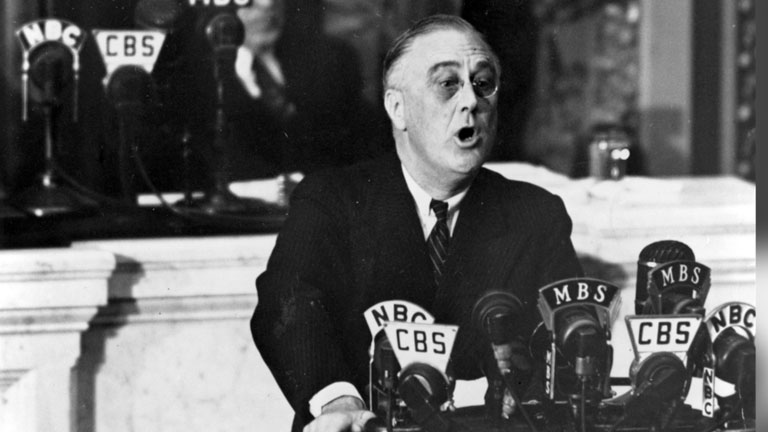
Franklin D. Roosevelt (whitehouse.gov)
The 2016 presidential contest may very well pit two New Yorkers, Hillary Clinton and Donald Trump, against each other. In the 29 presidential elections from 1900 to 2012, New Yorkers headed major tickets nine times. Two (Theodore Roosevelt and Thomas Dewey) ran twice; one (Franklin D. Roosevelt), 4 times. New Yorkers faced each other twice (1904 and 1944), presaging the seemingly likely 2016 matchup.
New York's prominence in national politics is no surprise. Arguably the nation's most historically important state for many years, New York is something of a proving ground for the presidency. Succeeding as New York governor, for instance, demonstrates capacity to lead, address complex issues, manage politics successfully, and get things done. Simply serving as governor or U.S. senator from New York is almost always a guarantee of a high-profile. New York for many years had more electoral votes than any other state and even now has a sizeable number.
New York's significant role in presidential elections has a long and illustrative history.
1904: The judicious judge vs. the energetic president
Theodore Roosevelt (R), New York governor 1899-1901 and then vice president, became president in 1901 after the assassination of President William McKinley. Over the next three years, TR compiled a vigorous record, promoting conservation, taking legal action under the anti-trust law to dissolve a powerful railroad consortium called the Northern Securities Company, and supporting a revolution in Panama to achieve independence from Columbia and then negotiating an agreement to build a canal there to link the Atlantic and Pacific oceans. He was easily nominated by his party to seek a full term as president.
Alton P. Parker (D), chief judge of the New York Court of Appeals since 1898, was a proven Democratic vote getter in what was then a predominantly Republican state. His solid, well-reasoned opinions gave him an aura of authority and reliability, an advantage, his backers insisted, over the sometimes impetuous TR. Parker in January 1904 wrote the majority opinion in the case of People v. Lochner, validating a New York law regulating the working and safety conditions of bakery employees. It was an eloquent affirmation of the government's authority to regulate industry, and it helped him secure the Democratic party's presidential nomination in the summer.
Parker resigned as chief judge and, following the custom of the day, did not travel or make speeches beyond a few from the front porch of his estate, Rosemont, in Esopus, on the Hudson River near Kingston. He campaigned on frugality and economy in government, cautioned against foreign adventuring, and accused TR of secretly soliciting campaign contributions from railroad and banking magnates. TR denied the accusation and pointed to his energetic, proactive record as President. Parker generated little enthusiasm. A cartoon in the fall showed him in a rowboat near his dock at Rosemont, leisurely fishing and lamenting, "If I could only hook a real issue!" Americans in the early 20th century were ready for strong presidential leadership. TR won easily, garnering nearly 60% of the popular vote.
1912: the resurgent New Yorker
TR served as president until 1908 and was succeeded by his friend and Secretary of War, William H. Taft. TR had so much confidence in Taft that he easily convinced Republican leaders that Taft was his logical heir apparent. Roosevelt went off on a hunting trip to Africa and when he returned in June 1910, he quickly expressed displeasure at the way his successor had handled things. Taft, amiable and accommodating, had signed a tariff bill that increased rates on imported goods, weakened TR's conservation policies, and given in to Republican conservatives in Congress on other issues.
TR began attacking Taft and articulating a new political philosophy which he called "the New Nationalism." Roosevelt condemned court decisions that nullified state regulatory statutes and declared that "property shall be the servant, not the master, of the commonwealth...The...essence of any struggle for healthy liberty has been, and must always be, to take from one man or class of men the right to enjoy power, or wealth, or position, or immunity, which has not been earned by service to his or their fellows." Roosevelt sought the 1912 Republican nomination and won most of the primaries in the handful of states that had them that year. But Taft supporters denounced TR as a dangerous power-hungry radical who if elected might wield unprecedented executive power. They vowed to stop him at all costs. Taft forces controlled many state delegations and the president was renominated.
TR and his supporters cried foul, left the Republican convention, and then formed a new party, the Progressive Party, dubbed the "Bull Moose" party after TR declared he felt as "fit as a bull moose." The Progressive platform included workmen's compensation, old-age insurance, woman suffrage, and federal regulation of business, built around the slogan "Let the People Rule!" TR campaigned energetically, narrowly escaping assassination when a deranged man fired at him in Chicago. The Democrats nominated Woodrow Wilson, who had served as a progressive New Jersey governor and before that was president of Princeton University. Wilson campaigned on a platform of "the New Freedom," including strong federal regulation of business. Taft waged a weak, dispirited campaign. With the Republicans effectively split between Roosevelt and Taft, Wilson triumphed easily, Roosevelt came in second, and the hapless Taft carried only two states, Utah and Vermont.
1916: the progressive New York governor and judge
Woodrow Wilson pushed several progressive reforms through Congress, including the Federal Trade Commission, the Federal Reserve Act, a strong anti-trust law,, and a lower tariff. But after World War I began in 1914, public attention shifted to the balance between defending American trading rights on the high seas and at the same time avoiding being drawn into the war. Easily re-nominated in 1916, Wilson espoused military preparedness but also pledged to keep the nation at peace, campaigning on the slogan "he kept us out of war."
Republicans, reunited after their 1912 split, nominated former New York Governor and Supreme Court Justice Charles Evans Hughes. TR and Taft both endorsed him. Hughes had been a strong, progressive governor and a moderate, capable judge who favored government regulation. But he was an uninspiring campaigner, his speeches limp, too often laden with platitudes. Hughes so straddled the issue of peace and war that the Democrats dubbed him Charles "Evasive" Hughes.
The result was close in a number of critical states. The election hinged on California. That state's Republican governor, Hiram Johnson, who had been TR's 1912 vice presidential running mate, was lukewarm on Hughes. One day during the campaign, Hughes and Johnson were in the same hotel in Long Beach for several hours, but, due to a scheduling snafu, did not meet with each other. Hughes later apologized but Johnson thought Hughes had snubbed him and gave him only nominal support. Wilson narrowly carried California and the election. (The next year, 1917, Germany began attacking American ships with its submarines, leading Wilson to ask Congress for a declaration of war. Hughes later went on to be Secretary of State and Chief Justice of the United States.)
1928: New York's "Happy Warrior"
America was prosperous and at peace in 1928, which many people attributed to the benign, pro-business policies of Republican Presidents Warren G. Harding (1921-1923) and Calvin Coolidge (1923-1929). When Coolidge announced he would not run in 1928, Republicans selected his Secretary of Commerce, Herbert Hoover, as their candidate. Hoover, an engineer, had won acclaim for leading relief work in Europe after World War I and promotion of business and prosperity as commerce secretary. He campaigned as heir apparent of the two previous Republican presidents and promised to continue America's sunny prosperity.
People were satisfied, even complacent. It seems unlikely any Democrat could have defeated Hoover in 1928. Democrats selected a strong contender, Alfred E. Smith, governor of New York 1919-1921 and 1923-1928. Smith, the "Happy Warrior," was one of New York's most effective governors, consolidating state government, enacting the modern state budget system, increasing aid to education, and taking other initiatives. But Smith was also a "wet" -- he opposed prohibition, the outlawing of alcoholic beverages, which had been in effect since 1919. He was also a Catholic at a time when anti-Catholic bigotry was strong. Opponents whispered that Smith would be under the control of the Vatican and might even bring the Pope himself to Washington to take charge of the government.
Smith espoused a vision of a federal government which would address the issues facing the nation "along sane, sensible progressive lines." His informal campaign song, "The Sidewalks of New York," reminded audiences everywhere he spoke of his New York roots. That helped in some places but hurt the candidate in other areas which associated New York City with concentrated wealth, urban problems, and overly-liberal values, and associated Smith himself with the New York Tammany Hall Democratic organization. Smith did well in urban areas but he carried only seven states, all but one in the south, which had been strongly Democratic since the time of the Civil War.
READ ON - this is page 1 of 3 - New York Governor FDR runs for President and much more - Continue to page 2 of 3
***
Dr. Bruce W. Dearstyne's latest book is The Spirit of New York: Defining Events in the Empire State's History, published in 2015 by SUNY Press.
***
Have an op-ed idea or submission for Gotham Gazette? Email This email address is being protected from spambots. You need JavaScript enabled to view it.
The Next Step to Helping Immigrant Families Thrive
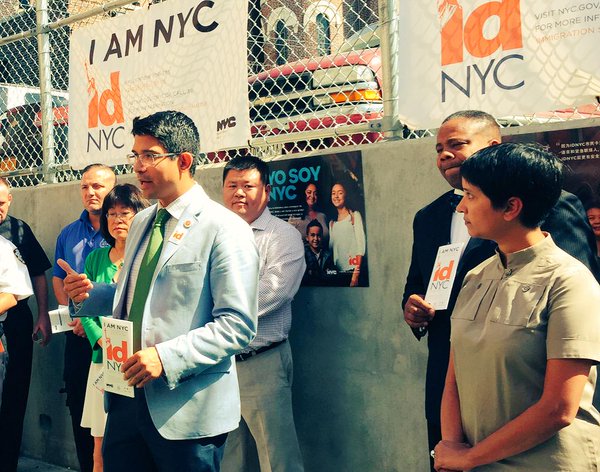
Council Member Menchaca, a co-author, promotes IDNYC (photo: @IDNYC)
In recent years, New York City has taken tremendous strides forward in supporting immigrants. Many of Mayor de Blasio's signature initiatives—particularly universal pre-kindergarten (UPK), IDNYC, and community schools—have offered vital new services to New Yorkers across the city that have been tremendously beneficial for immigrants seeking to fully integrate themselves into our society and see their families thrive.
Now, there's another critical step that New York City can take to build on these immigrant integration successes: investing in adult education.
New York City has the largest immigrant community of any city in the United States, with three million immigrants from all over the world—that's more than the entire population of Chicago. Immigrants help drive our city—accounting for 45 percent of the workforce and 49 percent of small business owners, and endowing the Big Apple with much of its incredible cultural vibrancy.
New York City has led the way in offering vital services to immigrant communities, in particular to children from immigrant households. But it's critical that we now move forward to ensure that immigrant parents are equally equipped to take advantage of new path-breaking city programs, and that means supporting adult literacy initiatives that help immigrant New Yorkers learn English and ensure basic reading and writing skills.
Adult literacy is crucial for helping parents know how to navigate the city and unlock the power of major policy achievements. To make UPK, IDNYC, and community schools live up to their potential, for example, we need to make sure parents are equipped with the tools they need to access them. English-speaking parents have a much easier time ensuring their children's educational success—for example, by being able to fully engage during parent-teacher meetings—and being able to proactively seek out the indispensable services provided at community schools.
Adult literacy is necessary for our immigrant communities, and more broadly, it's important for the economic well-being of our city. As a new report by the Center for Popular Democracy and Make the Road New York has found, directing additional resources toward adult literacy will raise immigrant New Yorkers' wages and increase tax revenues.
Take the example of Yanilda, a Dominican immigrant enrolled in English classes at Make the Road New York in Bushwick. Since beginning her classes, Yanilda notes, "I can help my niece with her homework. She's in kindergarten now and when I help her read her books, I learn too." Yanilda is also confident that her steadily improving English will help her get a better job. For her and thousands of others citywide who are lucky enough to have a spot in a free English class, adult literacy programs offer a win-win.
There are 1.7 million and 2.3 million Limited-English proficient residents like Yanilda, in New York City and New York State, respectively, according to the Census, and many others in need of basic literacy courses. Within immigrant communities there is a tremendous unmet need for English classes and adult basic education, with state funding now only sufficient to accommodate one of every 39 New Yorkers who need ESOL (English Speakers of Other Languages) classes. Simply put, adult literacy funding has not kept pace with the need.
That's why we need New York City to dedicate $16 million in its upcoming budget to new investments to help 13,300 students access adult literacy programs, including ESOL, Basic Education in Native Language (BENL), Adult Basic Education (ABE), and High School Equivalency Preparation (HSE).
We've made so much progress in expanding services to immigrant New Yorkers since Mayor de Blasio took office. It's time for New York City to take the next step in full immigrant integration by investing in adult literacy.
***
Carlos Menchaca is a member of the New York City Council. Theo Oshiro is the Deputy Director Make the Road New York. On Twitter: @cmenchaca & @maketheroadny.
***
Have an op-ed idea or submission for Gotham Gazette? Email This email address is being protected from spambots. You need JavaScript enabled to view it.
New York's Coming ConCon Battle

(photo via The Governor's Office on flickr)
New York's Constitution mandates that every 20 years New Yorkers be granted the opportunity to vote on whether to call a state constitutional convention. This referendum is next on the ballot on Nov. 7, 2017.
The unique democratic function of this referendum is to provide New Yorkers with a mechanism to bypass the Legislature's gatekeeping power over constitutional reform, which is a problem when the Legislature has an institutional conflict of interest with the people. Such a conflict occurs when the Legislature controls the constitutional powers of competing branches of government (e.g., the judicial and executive branches of government) and its own internal powers (e.g., legislative ethics, term limits, campaign finance, ballot access, and redistricting).
Since 1776, what is now the United States has had 236 state constitutional conventions and New York nine.
Fourteen states, including New York, have the periodic convention referendum. The last one to pass in the U.S. was in 1984.
My research finds two stages to the recent pro and con lobbying campaigns over convention referendums. The first stage is dominated by "yes" advocates; the second, which only occurs if the referendum polls well, is dominated by "no" advocates.
So far, New York is following this pattern, as it did in 1997, the last time the referendum was on the ballot. Since January 2015, 16 newspaper op-eds have called for a convention, while none has opposed. Governor Cuomo has announced support for a convention, including setting up a $1 million preparatory commission, while no prominent state politician has announced opposition.
Partially due to such one-sided public arguments, calling a convention is way ahead in the polls, leading 69% to 15% according to a Sienna Research Institute poll. Despite this lead, most political experts believe that the convention referendum will lose because waiting in the wings for a last minute PR blitz is a well-organized and deeply-financed opposition, which includes the special interest groups that excel at influencing the Legislature and fear the convention as a populist institution.
Opponents' campaign arguments directed to the general public will include: A convention will be outrageously costly, thoroughly corrupted by both the Legislature and special interests, wastefully redundant with the Legislature, likely to result in either too little or too much change, and controlled by majorities who will violate minority rights and minorities who will violate majority rights.
These arguments need to be subject to well-informed scrutiny. This can only be accomplished if media, think tank, and other public opinion leaders bring the opposition out of the shadows. Two-sided public debates, including dueling op-eds and interview programs, should begin now.
In a democracy, one reason public campaigns for vital elected offices, such as U.S. President, start many months before election time is that time is needed to have a well-informed debate. Open, sustained conflict also breeds popular interest. If opponents aren't willing to engage publicly, the public and press will remain uninformed, which allows last minute, sound-bite sized fearmongering to thrive.
Starting a two-sided public debate early also helps compensate for New York's loophole-ridden campaign finance referendum disclosure laws, which aren't a match for modern, anti-convention referendum politics, including the complex influence-laundering schemes that accompany them. For example, New York doesn't require disclosures during the last 19 days before a referendum—just when the attack ads become most intense.
No more fundamental right exists in a democratic system of government than the people's right to reform their government despite legislative opposition. New York's upcoming debate over how best to implement that right should be treated as seriously as the U.S. presidential election. The framers of New York's 1846 Constitution who bequeathed this right to us in the form of the periodic state constitutional convention referendum would have wanted no less.
Instead of a one-sided pro convention "debate" followed by a one-sided last-minute anti-convention "debate," we need a sustained multi-sided debate commensurate with its importance.
***
J.H. Snider, the president of iSolon.org, is the editor of The New York State Constitutional Convention Clearinghouse and author of Does the World Really Belong to the Living? The Decline of the Constitutional Convention in New York and Other US States, 1776–2015.
***
Have an op-ed idea or submission for Gotham Gazette? Email This email address is being protected from spambots. You need JavaScript enabled to view it.
School Diversity Benefits All Children - and Parents
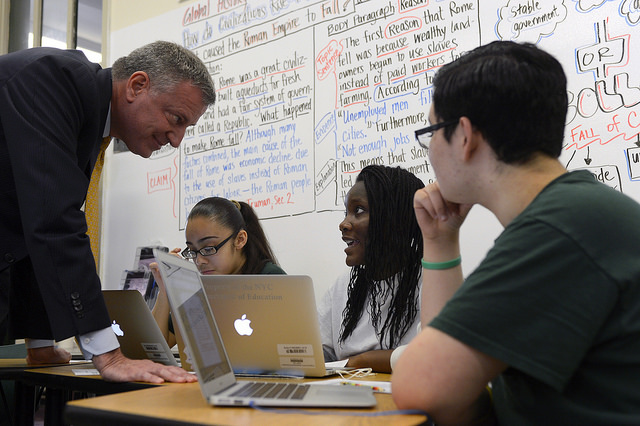
Mayor de Blasio on a school visit (photo: Rob Bennett, Mayor's Office)
My four-year-old daughter has a good friend at preschool who happens to have the same name. I'll call them both "Maya." My daughter is Asian, and her friend is Latino. Recently, a classmate said, "There are two Mayas in our class. One is white and the other is brown." My Asian daughter is the "white" Maya. The classmate's mom probed why he categorized the two Mayas this way, but didn't get much of an answer. Innocently, the boy didn't realize why his categorization was inaccurate or unusual.
In preschool, children are just beginning to make sense of things, applying lessons and parallels - sometimes accurately and sometimes not - from the world around them.
My daughter attends University Settlement Park Slope North/Helen Owen Carey Child Development Center ("Helen Owen Carey"), which manages to maintain a rare balance of racial and income diversity. I really appreciate this aspect of our preschool. Exposure to classmates from a wide range of racial and economic backgrounds is important. Young children need precisely this type of exposure, even if the process by which they come to understand it can be messy. Incidents like the above are awkward, but it's good that my daughter and her classmates are at a school where children can start to take stock of our diverse community. I am glad that Maya's classroom more closely mirrors the population of Brooklyn as a whole, and not just that of our Park Slope neighborhood.
Maya and her classmates have unique learning opportunities as a result of their school's student body, both formally and informally. In a lesson themed "All About Me," Maya and her classmates examined their physical appearance including differences in skin tone which they later put on a color spectrum, indirectly allowing the children to consider race.
Parents and families can also play an important role in this learning. Each spring, my husband and I go into our children's preschool classrooms to teach mini-lessons about two holidays related to our ethnic heritage, Chinese New Year and Burmese New Year. Even casual exposure can expand young children's sense of the world. My three children have sampled Haitian food at preschool potlucks, learned about latkes and matzo, and shared homemade mochi at their own birthday parties.
We need more public school classrooms that look like my daughter's preschool class.
The New York City Department of Education's recent decision to allow principals at seven public schools to set aside a percentage of seats for particular categories of students (such as low-income students, English Language Learners, or those involved with the child welfare system) in the interest of school integration is a promising and needed measure.
Once a more diverse study body walks through the classroom doors, however, a new and more intensive challenge begins – that of educating students of widely varying backgrounds and building a community from these children and their parents. And while it may be simpler to work with kids with roughly the same background and starting point, we know the value of a more diverse learning environment for everyone involved.
Parents in a racially and economically diverse school do face unique challenges when negotiating relationships and building community at those schools. For the most part, parents – including myself - at our preschool socialize more with others like themselves – racially, economically, or otherwise. This unfortunate segregation occurs politely and all too naturally, despite good intentions, and persists although many Park Slope parents chose the school precisely because of its diversity.
However, I have observed how we all grow more comfortable with one another over time and shared experiences. We nod "hello" when we run into each at drop-off or pickup, racing to avoid the dreaded late drop-off or pickup that occasions a visit to the administrative office. Parents share tips about the kindergarten application process, often in groups wider than our social circles. And so on.
Community building is tough, especially within diverse communities, even when this very diversity is what drew you into that community in the first place. I am thankful for the chance to participate in Helen Owen Carey's community. Maya's older brother now attends PS 321, a popular and sought after public elementary school in Park Slope. I've been satisfied with the caliber of instruction he's received there and appreciate the school's deeply engaged parent community. Unfortunately, it lacks the diversity I so love about our preschool. My children have been exposed to a level of diversity before entering kindergarten that they may not experience again in New York City public schools – maybe in their educational careers. That alone is priceless.
I benefit from the fact that my son's elementary school is a one mere block from my apartment, and the fact that playdates with my son's classmates are easy to arrange because everyone lives within five minutes. I have enjoyed getting to know many of his friend's parents, with whom I have a lot in common. That said, there is value in exposure to – and perhaps even building a more tenuous relationship with – parents with whom one does not have a lot in common and most likely will never become close friends with. Learning about other parents' experiences and the challenges they may face has expanded both my sense of the privilege I enjoy, as well as my broader understanding of educational equity.
As for my three children, as much as I appreciate the fact that we are zoned for PS 321 and what that means for their educational foundation, I hope they will not only reap benefits from their time in preschool but have more opportunities for rich, demanding, and diverse educational experiences in public school and beyond.
A good preschool friend of my son lived far away in another part of Brooklyn and is from a working class background. I didn't get to know his parents beyond the usual salutations and pleasantries, and we have not kept in touch. But I hope my son will remember his old friend should he meet other kids who remind him of the friend and that this will help my son keep an open mind and heart to others from different racial and income backgrounds. This hope might be impossibly idealistic, but it is ultimately what we need to achieve from school integration.
***
Khin Mai Aung has three children aged two, four, and six who attend preschool and public school in New York City. Previously, she was Director of the Educational Equity Program at the Asian American Legal Defense and Education Fund, and she currently conducts civil rights enforcement for the state of New York. The views contained in this article are solely her own.
***
Have an op-ed idea or submission for Gotham Gazette? Email This email address is being protected from spambots. You need JavaScript enabled to view it.
State Senate GOP Plays Politics with Anti-Semitism at CUNY
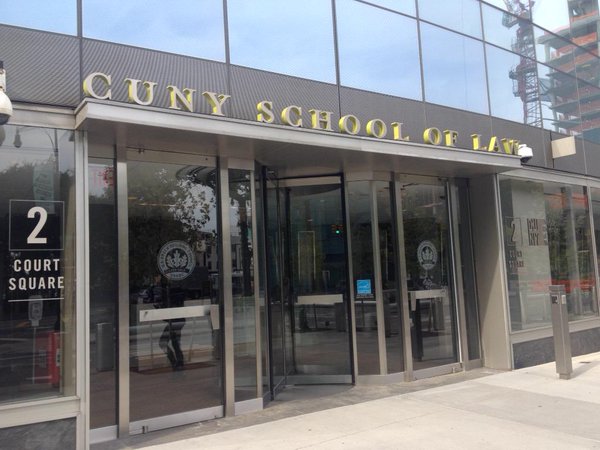
CUNY School of Law
New York State Senate Republicans are using the existence of anti-Semitism on CUNY campuses as their latest excuse in a ruse to gut the city university system's budget by $485 million, and shifting the financial burden of the cuts to CUNY students and their families.
Last week, Senate Republicans including Senator Kenneth LaValle, who chairs the Senate Committee on Higher Education, vowed to slash CUNY funding in order to "send a message" about anti-Semitism and intolerance on CUNY campuses. This message that Republican senators are sending is clear: Senate Republicans are using Jewish students on CUNY campuses as pawns in a budget battle that belittles incidents of anti-Semitism and excuses draconian budget cuts that would jeopardize the financial health of my classmates.
Intolerance and discrimination are real, and are endemic in our society. Our elected leaders should make a conscious effort to make all public institutions, including CUNY, as free from discrimination and intolerance as possible. As a Jewish CUNY student, I have witnessed my fair share of anti-Semitism (and other discrimination) within the CUNY system. Cutting funding is the last thing to do in response, though.
I cringe when I hear my fellow students decry the "Zionist administration" at CUNY or when thinly-veiled prejudicial comments are used freely on my campus and others against various groups. I welcome, encourage, and applaud efforts on a city and state level to address bigotry and prejudice on CUNY campuses. But the Republican effort to tie funding dollars to incidents of anti-Semitism will only further alienate students who feel victimized by intolerance.
Making matters worse, this politically motivated move endangers the prospects of 500,000 CUNY students and countless future students in our city who will consider enrolling at a CUNY school because of the affordability and quality of education that the system offers.
As the threat of unprecedented budget cuts lingers, CUNY students are growing anxious that we will not have the opportunity to continue our tradition of service. Over the past few weeks, my classmates and I have protested the potential cuts - we are fearful that our tuition will increase exponentially while our opportunities decrease. Lawmakers in Albany cannot allow these cuts to go through, resulting in the loss of precious programs and the dismissal of invaluable faculty members.
While the governor's office says that CUNY is fully funded in the executive budget, we want to make sure that the budget deal reached before the end of this month does indeed leave CUNY heading in the right direction, not backward. We certainly cannot allow Senate Republicans to push for cuts under the guise of punishing disturbing episodes of anti-Semitism. We must fight these episodes with more education, not less.
The State's historic commitment to funding the CUNY system has ensured that our quality education remains affordable, and that students of all backgrounds and financial circumstances have access to this education. An affordable CUNY system is a system that leads to students giving back to our city and state.
For example, the CUNY School of Law student body is largely focused on public-interest law. From defending indigent clients in criminal court to advocating for legislation that makes public benefits accessible to all New Yorkers, CUNY Law students are investing back into the people of our city and state.
Now, more than ever, we need our state government, including and especially the Senate GOP, to have our backs. Addressing anti-Semitism and discrimination on CUNY campuses is a legitimate concern that should be confronted. But conflating incidents of anti-Semitism and prejudice with the need to fully fund CUNY schools is a disservice to the people of this city and state.
The path forward is clear: fully fund CUNY and also make every effort necessary to tackle discrimination on CUNY campuses.
***
Jeremy Rosenberg is a student at CUNY Law School and president of the CUNY School of Law Democrats. He is on Twitter @JeremyR1992.
***
Have an op-ed idea or submission for Gotham Gazette? Email This email address is being protected from spambots. You need JavaScript enabled to view it.
Letter to the Editor: Getting the Facts Right on the Governor's Budget
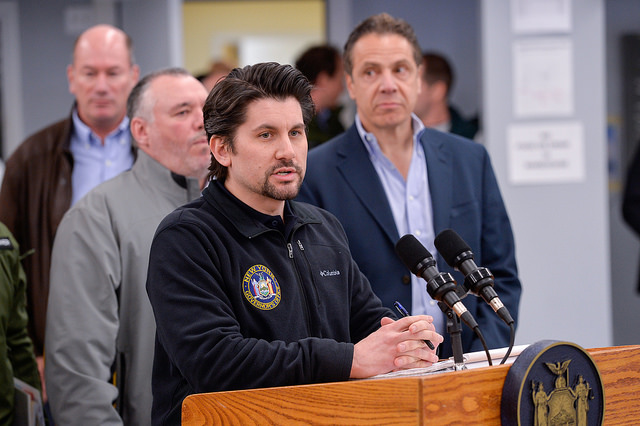
Director of State Operations Jim Malatras, the author (photo: Governor's Office)
To the Editor:
Re: "Proposed CUNY Cuts Threaten the University's Timeless Mission" that ran on March 16.
It's important we separate fact from fiction for your readers. As we always have, the Governor's budget fully funds CUNY at a total of $1.6 billion. Any statement to the contrary is simply false or a direct attempt to play politics and mislead the public.
Governor Cuomo recognizes the importance of public higher education which is why we continue to make significant investments in CUNY. We want to ensure academic success and equality of opportunity for not just some, but all students. Yet the out of control administrative costs at CUNY continue to threaten this very mission. Consider this: The cost of administrative expenses today at CUNY is $4,634 per student or two times the average cost of what others pay in states like California, Massachusetts and Florida. These ballooning administrative costs come at the expense of students and faculty – and that is plain wrong.
CUNY must find ways to share services, reduce overhead costs and streamline back office functions. To guide this process, the state will appoint a management organization expert to restructure administrative office functions. This expert will be tasked with conducting a comprehensive review of CUNY and presenting a plan ahead of next year's budget.
Through improved fiscal management and smart restructuring, CUNY will be able to find cost savings, look for shared services with SUNY, and ultimately direct more money to the students, classrooms and faculty who need it most. This is a plan we can all get behind.
Sincerely,
Jim Malatras
Director of State Operations for Governor Andrew M. Cuomo
***
Have an op-ed idea or submission for Gotham Gazette? Email This email address is being protected from spambots. You need JavaScript enabled to view it.
CUNY Faculty’s Lost Decade & The Risk Ahead
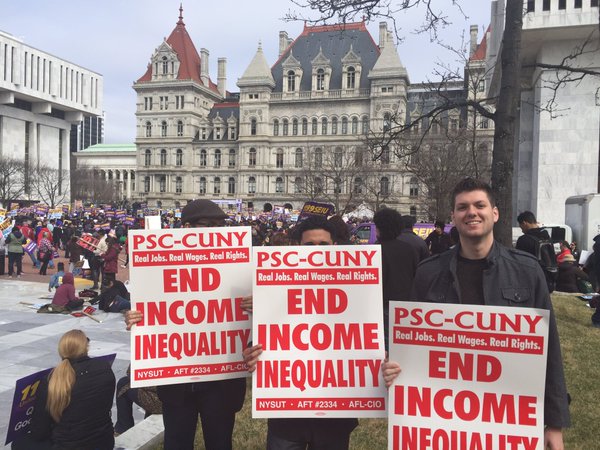
PSC CUNY rally in Albany (photo: Emma Powell)
The faculty at the City University of New York has lost a decade. Salaries at CUNY have been frozen since the October 2010 expiration of our contract and even before that they failed to keep pace with inflation. In 2015, assistant and associate professors at the top salary step earned 92% in real terms of what they earned in 2006. Full professors at the top step did slightly better, taking home just under 96% of their 2006 salaries.
Since the contract expired, living costs in New York have risen 7.6%. Food is up 10.9%, rent 15.8%, and medical care 18.2%. Tenured full professors like me feel this on a daily basis as we struggle to balance our families’ budgets. But we’re the lucky ones.
Adjunct faculty do much of the heavy lifting at CUNY, teaching more than half of all classes, and for salaries that can be less than $3,000 per course, with little job security. In return for this paltry wage, they run classes, grade papers, and hold office hours for students. The adjuncts are the sorriest victims of the salary freeze, with many commuting frantically from one campus to another — from the Bronx to Staten Island — in an exhausting struggle to survive and to preserve a toehold in the academy and a professional identity. No wonder CUNY campuses are plastered with posters decrying “adjunct poverty.”
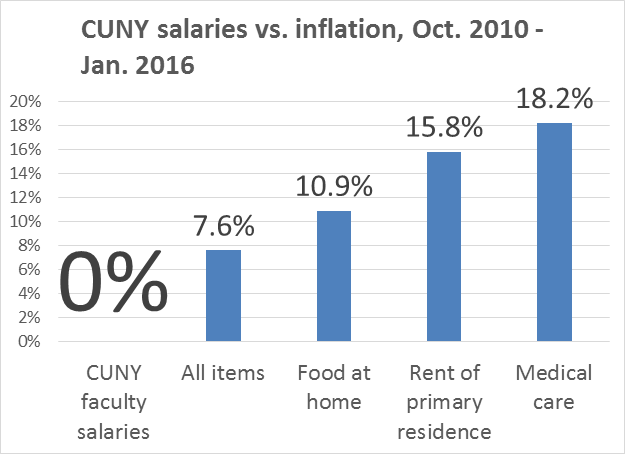
Students too suffer from budget cuts. Fewer courses are offered in their majors, lengthening time-to-degree. Adjuncts may not have a base at any campus and are often unavailable to meet with students or to write recommendations needed for graduate school applications. Regular faculty have to perform tasks that elsewhere are assigned to support staff, such as shopping for food for student receptions or entering course registrations in the unwieldy CUNYFirst computer. This means they have less time to advise students or to write grants that bring CUNY much-needed overhead.
CUNY has been the great equalizer, fueling upward mobility for generations of New Yorkers. Today its 24 campuses enroll 275,000 degree students and another 247,000 continuing students — some 6% of the city’s population. CUNY rightfully boasts that 40% of undergraduates were born abroad, 44% are first-generation Americans, and 42% are the first generation college students. More than half come from households earning less than $30,000 a year. Eight out of ten Latino and African-American undergraduates in the city go to CUNY schools.
CUNY remains a pillar of New York’s economy. It grants more than one-third of business degrees awarded by New York City institutions and trains one-third of the city’s teachers and many of the nurses and technicians in local hospitals. In a city where luxury condos and billionaire towers sprout like mushrooms, CUNY’s $2.7 billion capital program accounts for 20% of total construction, generating 14,000 jobs. Students at 300 high schools take courses through CUNY’s College Now program.
Why does a university that makes such an immense contribution to the city freeze its faculty pay? After five years of negotiations, management made its first salary proposal, offering three years of retroactive zero percent increases, subsequent hikes totaling 6%, and an expiration date of October 2016, a mere eight months from now. The union rejected this below-inflation “raise.”
CUNY Chancellor James Milliken and several CUNY college presidents have made tepid declarations in favor of resolving the standoff. The real obstacle is in Albany, where Governor Andrew Cuomo’s unremitting hostility to teachers’ unions extends to CUNY faculty and workers.
In 2011, Cuomo launched SUNY 2020, a program of challenge grants for capital projects and policies he argued would lead to instructional innovation and hiring at all the state’s public universities, including CUNY. The plan required that students pay $300 more each year for five years and pledged that the state wouldn’t reduce support for CUNY. Legislators voted for the hikes believing they would generate revenue to improve academic and student-support services at CUNY. Since 2012, however, the state — the source of most of CUNY’s budget — has failed to cover cost increases for rent, utilities, equipment, fringe benefits and contractual salary steps.
State revenues rose 5.6% in 2015, but in December Cuomo vetoed a bill that would have required the state to fund such increases. In January, he signed an executive action raising the minimum wage for SUNY workers to $15 an hour, but excluded state workers at CUNY. Also in January, the governor tried to shift $485 million of CUNY’s budget from the state to the city. Currently, the city funds about 30% of CUNY community colleges and the state funds CUNY senior colleges, an arrangement in place since the mid-1970s.
To Cuomo’s credit, his 2017 proposed budget includes $240 million for agreements with CUNY unions. But the $240 million is contingent on the $485 million cut in state funding. Even if the money for retroactive pay survives in the Legislature, the amount is insufficient to restore adequate salaries for faculty and other CUNY workers.
CUNY is used to crisis and austerity, with a $51 million shortfall last year and across-the-board cuts now of 3% at senior colleges. Per pupil funding is 17.4% below 2008 in inflation-adjusted terms. Top administrators’ salaries continue to climb, so the budget is balanced on the backs of faculty, workers, and students, who pay rising tuition for an education that is ever harder to deliver.
This is penny-wise and pound-foolish. CUNY’s 6,700 full-time faculty members include world-renowned experts in every field. Each year they win millions of dollars in grants, author thousands of scientific papers, and mentor new generations of informed citizens. Many depart for better jobs elsewhere. Those who remain work more years at top salary steps than they otherwise would simply to accumulate enough retirement savings. It is increasingly difficult to recruit scholars to the lowest-paid faculty in one of the country’s highest cost-of-living regions, and it is usually impossible to replace professors who leave or retire.
The neglect of CUNY exacerbates inequality, deprives hundreds of thousands of students the education they deserve, and lessens New York’s competitiveness in the global economy. New Yorkers need to decide if they want to invest in the future of their city and, if so, make sure that our elected leaders know.
***
Marc Edelman is professor of anthropology at Hunter College and the CUNY Graduate Center.
***
Have an op-ed idea or submission for Gotham Gazette? Email This email address is being protected from spambots. You need JavaScript enabled to view it.
Proposed CUNY Cuts Threaten the University's Timeless Mission
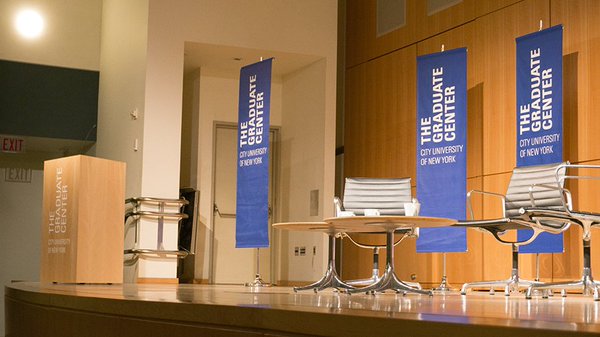
At the CUNY Grad Center (photo via @GC_CUNY)
Roused from the self-imposed seclusion of doctoral dissertation data entry, I was awakened by attention to the recently-proposed drastic budget reduction to our nation's largest urban university system – the City University of New York (CUNY). These are cuts that simply cannot be allowed to go through and this is an issue that affects all of New York, not just the faculty, students, and staff of CUNY.
Public funding for higher education in New York City is the lifeline for many, offering a college education that is accessible, affordable, and high quality. The pending state budget, proposed by Governor Cuomo, includes a $485 million cut from the CUNY operating budget. Such a cut is a direct threat to CUNY, where so many who would not otherwise have access public higher education can actually afford to attend.
We must ensure that CUNY stays affordable.
CUNY's mission since 1847 has been "to provide education to the children of the whole people of New York City." Given financial facts and persistent economic inequality, not everyone can afford one of the highly-ranked private institutions located throughout our city. CUNY provides a high-quality education for a fraction of the cost.
I've been a nurse for 27 years and have two bachelor's and two master's degrees, all from private institutions. A doctoral degree was the next logical step. I chose to come to the Nursing Science Program at The CUNY Graduate Center to pursue my PhD after exploring my options in the tristate area. The Graduate Center is the hub for PhD and Masters programs at CUNY. The very reasonable price of tuition was attractive, but after looking at the options available in the city, what appealed to me most was the expertise and experience of the nursing faculty in the program.
While my story is not indicative of the large majority of CUNY students, it is not unique for the reasons that I chose CUNY and the positives of my experience there.
Composed of scholars and researchers from the three senior CUNY colleges with nursing programs (Hunter, Lehman, and the College of Staten Island), I was enticed, then offered the opportunity to matriculate and to be able to learn, develop, and grow with them. Now in my fourth and hopefully final year with my dissertation nearly done, I regularly reflect on the quality of the program. Never more so than when I see that CUNY funding is in jeopardy.
I have gained so much, not just in perspective, but in the opportunities to have independent thought and pursue deeper expertise. This ability to explore and develop independent scholarly thought is so important, and a unique attribute of the CUNY experience - one different from other local doctoral nursing programs.
The past four years have been a wonderful experience here at the Graduate Center in the PhD in Nursing Science Program, a personal evolution into the world of nursing scholarship, research, and academia.
Cutting funding to the CUNY system and the Graduate Center would be a tragedy of epic proportions for the educational possibilities of future nurses and those who would become nursing faculty so desperately needed, especially in the 12 CUNY nursing programs in our five boroughs.
We can't allow Governor Cuomo and state legislators to eviscerate quality, affordable educational programs throughout CUNY, especially at the Graduate Center I call home. All New Yorkers must let them know that New York City needs the CUNY higher education programs; a $485 million cut in the budget is a direct threat to affordable and accessible higher education for the "children of the whole people."
***
by Randy E. Gross MS, RN, NP, CNS, WHNP-BC, ACNS-BC, AOCNP®, AOCNS®
Nurse Practitioner & Clinical Nurse Specialist
Doctoral Candidate – PhD in Nursing Science Program, CUNY Graduate Center
***
Have an op-ed idea or submission for Gotham Gazette? Email This email address is being protected from spambots. You need JavaScript enabled to view it.




